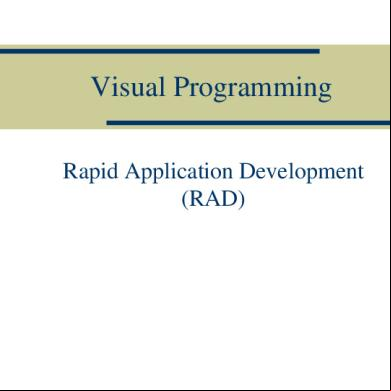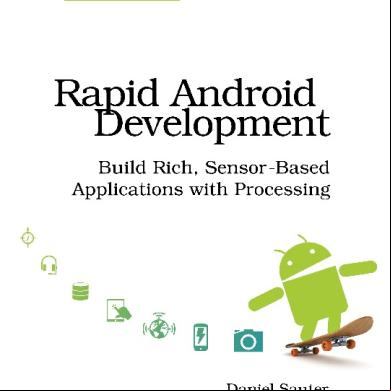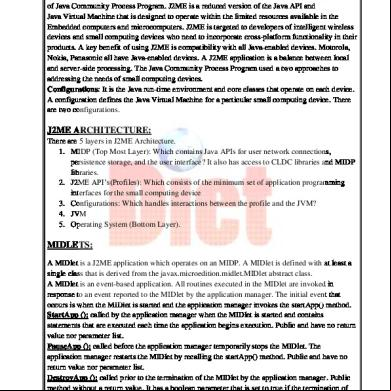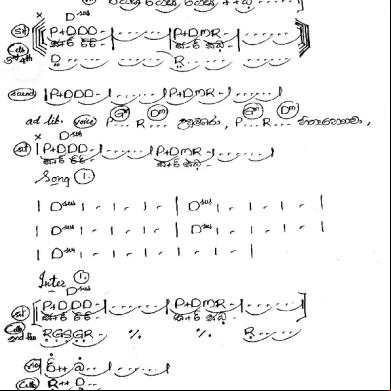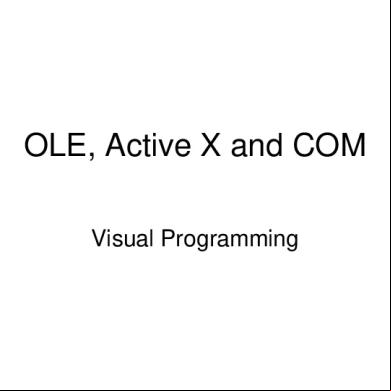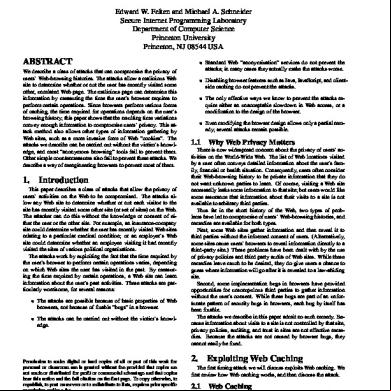Rapid Application Development (rad) n174o
This document was ed by and they confirmed that they have the permission to share it. If you are author or own the copyright of this book, please report to us by using this report form. Report 2z6p3t
Overview 5o1f4z
& View Rapid Application Development (rad) as PDF for free.
More details 6z3438
- Words: 457
- Pages: 17
Visual Programming Rapid Application Development (RAD)
1
Waterfall (Vs RAD) Longer Time More Documentation Larger Teams More Internal development (Less outsourcing) Less Flexibility in changing path/scope
2
Prototyping What is a prototype? - A model with certain appearances and behaviors to the finished product, while lacking in some of the features
3
Prototyping Initial Analysis
Define objectives
Specify
Prototyping completed
Evaluate
Construct
4
Prototyping What is a prototype ? 1. Throwaway prototyping 2. Evolutionary prototyping
5
Throwaway Prototyping Build prototype Evaluate and decide changes Discard (throwaway) prototype Build new (more) improved prototype Continue the above process till a Complete version satisfying all / most of the requirements is built 6
Evolutionary Prototyping Build prototype Evaluate and decide changes Modify the prototype into a new (more) improved prototype Continue the above process till a Complete version satisfying all / most of the requirements is built 7
Prototyping (vs. RAD) Discuss (Which of the two types of prototyping are most similar to RAD?) (Why is the other type not like RAD?)
8
Incremental Development The Spiral Model
9
Incremental Development (Vs RAD) Four phases :1.
2.
3. 4.
Inception determined scope and purpose of the project Elaboration-requirement capture and determine structure of the system Construction – building the software (s/w) Transition - installation
10
The Unified Software Development Process Four phases:1. Inception-determine scope and purpose of project 2. Elaboration-requirement capture and determine structure of the system 3. Construction – build s/w 4. Transition - installation
11
RAD - Introduction RAD is a software development process allowing the to build a usable system within a short period of time
12
Reasons to use RAD Discuss 1.
Good reasons -
2.
Bad Reasons –
(RAD Prerequisites – good time mgt. skill, good
cost mgt. skill) 13
Main Features of RAD Timeboxing (the most critical feature) Quality (very critical – cannot avoid)
Also important in all other methodologies
Iterative evolutionary prototyping
Iterate (Repeat) until done
Hybrid Teams – about 6 people
Developers, Fulltime s, others….
14
Main Features of RAD JRP – t Requirement Planning JAD – t Application Development
15
RAD Constraints “Fitness for Business Purpose” Informal Deliverables
Paper prototypes rather than informal deliverables
Less than 6 months
16
When RAD works / Fails RAD works better when :
Application – Standalone Performance and Reliability - Not critical Project Scope Constrained
RAD fails when :
Application interoperate with other programs Products – Mass market No high-end IS tools Product is Life or Time critical
17
1
Waterfall (Vs RAD) Longer Time More Documentation Larger Teams More Internal development (Less outsourcing) Less Flexibility in changing path/scope
2
Prototyping What is a prototype? - A model with certain appearances and behaviors to the finished product, while lacking in some of the features
3
Prototyping Initial Analysis
Define objectives
Specify
Prototyping completed
Evaluate
Construct
4
Prototyping What is a prototype ? 1. Throwaway prototyping 2. Evolutionary prototyping
5
Throwaway Prototyping Build prototype Evaluate and decide changes Discard (throwaway) prototype Build new (more) improved prototype Continue the above process till a Complete version satisfying all / most of the requirements is built 6
Evolutionary Prototyping Build prototype Evaluate and decide changes Modify the prototype into a new (more) improved prototype Continue the above process till a Complete version satisfying all / most of the requirements is built 7
Prototyping (vs. RAD) Discuss (Which of the two types of prototyping are most similar to RAD?) (Why is the other type not like RAD?)
8
Incremental Development The Spiral Model
9
Incremental Development (Vs RAD) Four phases :1.
2.
3. 4.
Inception determined scope and purpose of the project Elaboration-requirement capture and determine structure of the system Construction – building the software (s/w) Transition - installation
10
The Unified Software Development Process Four phases:1. Inception-determine scope and purpose of project 2. Elaboration-requirement capture and determine structure of the system 3. Construction – build s/w 4. Transition - installation
11
RAD - Introduction RAD is a software development process allowing the to build a usable system within a short period of time
12
Reasons to use RAD Discuss 1.
Good reasons -
2.
Bad Reasons –
(RAD Prerequisites – good time mgt. skill, good
cost mgt. skill) 13
Main Features of RAD Timeboxing (the most critical feature) Quality (very critical – cannot avoid)
Also important in all other methodologies
Iterative evolutionary prototyping
Iterate (Repeat) until done
Hybrid Teams – about 6 people
Developers, Fulltime s, others….
14
Main Features of RAD JRP – t Requirement Planning JAD – t Application Development
15
RAD Constraints “Fitness for Business Purpose” Informal Deliverables
Paper prototypes rather than informal deliverables
Less than 6 months
16
When RAD works / Fails RAD works better when :
Application – Standalone Performance and Reliability - Not critical Project Scope Constrained
RAD fails when :
Application interoperate with other programs Products – Mass market No high-end IS tools Product is Life or Time critical
17
